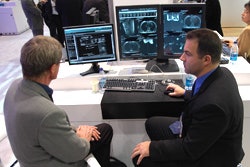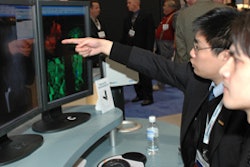(Radiology Review) Dual-source CT angiography (CTA) enables noninvasive, functional cardiac analysis, including accurate assessment of left ventricular myocardial function and reliable evaluation of regional wall motion, according to a pilot study by German researchers.
Radiologist Dr. Harald Brodoefel and colleagues at Eberhard Karls University in Tübingen studied 20 patients with suspected coronary artery disease or coronary bypass grafts using dual-source CT and compared volume- and time-dependent variables with a standard reference -- cine MRI. The results from their prospective study was published in the American Journal of Roentgenology (November 2007, Vol. 189:5, pp. 1064-1070).
The researchers used a dual-source CT system (Somatom Definition, Siemens Medical Solutions, Erlangen, Germany) that has "two tubes and corresponding detectors in a 90° geometry ... and provides a heart-rate-independent temporal resolution of 83 msec." Even better temporal resolution (42 msec) was achieved by applying a dual-segment reconstruction algorithm to all data. Depending of patient heart rate, temporal resolution ranged from 83 to 42 msec.
The authors used the modified Simpson's method (end-diastole and end-systole endocardial tracing of sequential short-axis views spanning the left ventricular cavity from the apex to the mitral annulus) to determine ventricular volumes and functional parameters, and compared the CT results with those of MRI.
They found a strong correlation between dual-source CT and cine MRI for end-diastolic volume, end-systolic volume, stroke volume, and ejection fraction; good correlation for peak ejection rate, peak filling rate, and regional wall motion; and moderate agreement for time-to-peak ejection rate or time-to-peak filling rate from end systole.
The authors predicted that dual-source CT will evolve as an appropriate means of assessing coronary arteries and ventricular function due improved temporal resolution (less than 83 msec), which enables assessment of volume- and time-dependent variables and hence global left ventricular function and regional wall motion.
"Dual-Source CT with Improved Temporal Resolution in Assessment of Left Ventricular Function: A Pilot Study"Harald Brodoefel et al
Department of Diagnostic Radiology, Eberhard-Karls-University, Tübingen, Germany
AJR 2007 (November); 189:1064-1070
By Radiology Review
December 28, 2007
Copyright © 2007 AuntMinnie.com



















